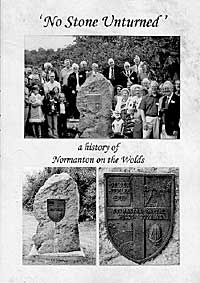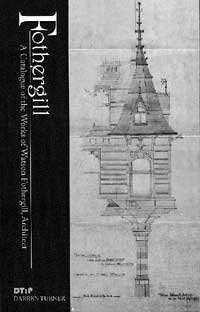Book reviews, Autumn 2012
NO STONE UNTURNED; A history of Normanton-on-the-Wolds.
Normanton-on-the-Wolds Parish Council, 2012. No ISBN.
£10.00 including postage from: Elliott News Service 19/21 Main Street. Keyworth, Nottingham NG12 5AA, Tel: 0115 937 6506.

This book is A4 format with 148 pages and profusely illustrated with colour and monochrome pictures, maps, diagrams, tables and plans. The book presents a very colourful impression with several blocks of text set against coloured backgrounds which, in the case of tables, serves to separate them from the general text in a useful way. Captions for illustrations are printed in red but this can be a little confusing and it would, perhaps, have been better to use a more conventional way of putting captions directly with the relevant illustration.
The book was researched, written and printed in less than a year with the intention of giving a copy to every household in the Normanton parish as part of the Queen’s Diamond Jubilee celebrations at the beginning of June 2012 – an aim which was achieved. There are, however, indications that the short timescale led to slips in the proof reading, an example of which is the several references to the Public Record Office rather than the National Archives (TNA) along with other errors.
Paragraphs in the text are separated by double spacing which adds to the impression that the chapters contain a series of notes and there is a deal of information of a general nature which is not directly related to Normanton although, no doubt, it would be argued to be of a contextual nature. There is not a great deal of analysis of the presented information which is rather a shame. The chapter which flows, and therefore reads, best is the last one dealing with the parish church at Plumtree; it would have been good if all chapters had been written in this style. Although there is some referencing ideally there could have been more; on several occasions I found myself wondering where the information came from. However, it is probable that the book is aimed at a general reader and so the lack of references is perhaps understandable.
Having raised these criticisms it must not be assumed that there is no validity in this book. There is a great deal of substantial information contained within the pages and the authors have to be admired and congratulated for producing such a work in a timescale of around 10 months. There is much in the book which will be of use to any subsequent researcher seeking to investigate either the whole or parts of Normanton-on-the-Wolds civil parish. Normanton, together with Clipstone-on-the-Wolds, is within the ecclesiastical parish of Plumtree and, until the boundary changes of 1984, the civil parish of Normanton encompassed much of what is now north Keyworth. As a result of the 1984 boundary changes Normanton lost over 90% of its population although it gained land acreage to counter that lost to Keyworth. Much of what is written is, therefore, relevant to a study of Keyworth. There is also information which will of use to researchers looking at the County, particularly that relating to medical matters of the 17th century.
This is a worthwhile book and highly recommended. It is certain that the editors could develop some of the chapters in, perhaps, a series of articles or even another book delving even deeper into the records they have located and consulted and, where relevant, using the oral testimonies (with the usual caveats about oral testimony) to produce an even deeper insight into the history of Normantonon-the-Wolds which, from the information contained in this book, is shown to be a most interesting community with a long history.
FOTHERGILL: A CATALOGUE OF THE WORKS OF WATSON FOTHERGILL, ARCHITECT. Compiled by Darren Turner. Blurb Books 2012 £13.95 plus p&p.

For members who are unfamiliar with Blurb books a little explanation might be helpful. Blurb is a way of using internet publishing to avoid the initial costs of traditional book publishing and printing. Once a book has been set-up on the Blurb site, using the provided software, one copy or many copies can be ordered. This reviewer uses the site to produce annual photo books of family activities which are produced in a highly professional presentation which is much nicer than the old style of photo albums. Blurb books are printed to order and, once ordered and paid for on-line take only a few days to arrive.
To order this book just go to www.blurb.co.uk, click on the Blurb bookstore heading towards the bottom right of the page and enter ‘Fothergill’ in the search box and then following the order procedure. Really very simple and efficient.
The book is 220 pages in slightly larger than A5 softback format. Whilst it does not contain any photographs is has several attractive line drawings of buildings together with maps showing the location of Fothergill works and a very useful chronology.
The compiler has used a variety of sources and, most importantly, primary sources in order to produce a most valuable book on the work of this prolific architect. In so doing he has sought to correct early misconceptions which have been perpetuated and presented as fact and, in many cases, has identified and corrected the source of these misconceptions.
The Foreword states two aims for the book: to produce a comprehensive catalogue of Fothergill’s works, bringing together as much information as possible about each project and to provide a resource for architects, planning and conservation officers and , of course, for those who have an interest in the architecture of Fothergill.
There are five chapters headed: Architectural Works, Minor Works, Miscellany, Employers and Employees and Sources and Bibliography. The Miscellany chapter deals with competition entries, unbuilt projects, street layouts, surveys, miscellaneous items and the awkward squad. The latter section is sub-headed, misattributions, possible projects and areas for further research. I found this fascinating reading. Within the chapter on employees there is a listing of the Nottingham projects undertaken by Lawrence George Summer (1854-1940) who worked with Fothergill from at least 1879.
Each of the entries provides details of Fothergill’s client, the building type, relevant dates, the builder, clerk of works where known, the cost, the location of the drawings, present use of the building, listing details and notes. Obviously the information for each project is not always completely available but the entries are very detailed and provide the available information.
This is a fascinating book, the result of extensive research and the compiler deserves congratulations and, indeed, thanks, for producing the work. It is an easily read book, one to be dipped into frequently to obtain information about a building or project. It will be much used by Fothergill enthusiasts and local historians alike and provides a much needed resource on the built environment of Nottingham and the county where Fothergill’s main practice operated. There are entries for works outside Nottinghamshire which makes the book complete.
Do buy the book, enjoy reading it and use it as a companion when looking at the architecture of Watson Fothergill (or Fothergill Watson as he was known after 1892 when he changed his name in order to continue his mother’s family line).